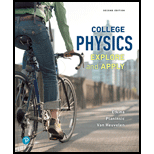
Incandescent lightbulbs—soon to disappear Australia Canada New Zealand, and the European Union started phasing out incandescent lightbulbs in 2009. The United States phased them out in 2014. These bulbs have provided light for the world for more than 90 years. What’s the problem?
Incandescent lightbulbs produce light when electrons (
Banning incandescent bulbs will reduce energy usage. According to the Department of Energy, about
Suppose you changed all incandescent lightbulbs to more energy-efficient bulbs that used one-fourth the amount of energy to produce the same light. About how many
a. 3
b. 10
c. 20
d. 50
e. 100
Want to see the full answer?
Check out a sample textbook solution
Chapter 25 Solutions
College Physics
Additional Science Textbook Solutions
College Physics: A Strategic Approach (3rd Edition)
Physics for Scientists and Engineers: A Strategic Approach with Modern Physics (4th Edition)
College Physics: A Strategic Approach (4th Edition)
Conceptual Physics (12th Edition)
Physics for Scientists and Engineers with Modern Physics
Tutorials in Introductory Physics
- Integrated Concepts Suppose you put on two pairs of Polaroid sunglasses with their axes at an angle of 15.0°. How much longer will it take the light to deposit a given amount of energy in your eye compared with a single pair of sunglasses? Assume the lenses are clear except for their polarizing characteristics.arrow_forwardSuppose you are facing a tall makeup mirror on a vertical wall. Fluorescent tubes framing the mirror carry a clockwise electric current. (i) What is the direction of the magnetic field created by that current at the center of the mirror? (a) left (b) right (c) horizontally toward you (d) horizontally away from you (e) no direction because the field has zero magnitude (ii) What is the direction of the field the current creates at a point on the wall outside the frame to the right? Choose from the same possibilities as in part (i).arrow_forwardYou are walking down a long hallway that has many light fixtures in the ceiling and a very shiny, newly waxed floor. When looking at the floor, you see reflections of every light fixture. Now you put on sunglasses that are polarized. Some of the reflections of the light fixtures can no longer be seen. (Try it!) Are the reflections that disappear those (a) nearest to you, (b) farthest from you, or (c) at an intermediate distance from you?arrow_forward
- The Tunguska event. On June 30, 1908, a meteor burned up and exploded in the atmosphere above the Tunguska River valley in Siberia. It knocked down trees over thousands of square kilometers and started a forest fire, but produced no crater and apparently caused no human casualties. A witness sitting on his doorstep outside the zone of falling trees recalled events in the following sequence. He saw a moving light in the sky, brighter than the Sun and descending at a low angle to the horizon. He felt his face become warm. He felt the ground shake. An invisible agent picked him up and immediately dropped him about a meter from where he had been seated. He heard a very loud protracted rumbling. Suggest an explanation for these observations and for the order in which they happened.arrow_forwardThere was a major collision of an asteroid with the Moon in medieval times. It was described by monks at Canterbury Cathedral in England as a red glow on and around the Moon. How long after the asteroid hit the Moon, which is 3.84105 km away, would the light first arrive on Earth?arrow_forwardCombing your hair leads to excess electrons on the comb. How fast would you have to move the comb up and down to produce red light?arrow_forward
- Can a sound wave in air be polarized? Explain.arrow_forwardLaser vision correction often uses an excimer laser that produces 193-nm electromagnetic radiation. This wavelength is extremer strongly absorbed by the cornea and athletes it in a manner that reshapes the cornea to correct vision detects. Explain how the strong absorption helps concentrate the energy in a thin layer and thus give greater accuracy in shaping the cornea. Also explain how this strong absorption limits damage to the lens and retina of the eye.arrow_forwardPhysics Many nocturnal animals demonstrate the phenomenon of eyeshine, in which their eyes glow various colors at night when illuminated by a flashlight or the headlights of a car (see the photo). Their eyes react this way because of a thin layer of reflective tissue called the tapetum lucidum that is located directly behind the retina. This tissue reflects the light back through the retina, which increases the available light that can activate photoreceptors, and thus improve the animal’s vision in low-light conditions. If we assume the tapetum lucidum acts like a concave spherical mirror with a radius of curvature of 0.750 cm, how far in front of the tapetum lucidum would an image form of an object located 30.0 cm away? Neglect the effects of the other structures of the eye, such as the cornea and lens.arrow_forward
 College PhysicsPhysicsISBN:9781285737027Author:Raymond A. Serway, Chris VuillePublisher:Cengage Learning
College PhysicsPhysicsISBN:9781285737027Author:Raymond A. Serway, Chris VuillePublisher:Cengage Learning Physics for Scientists and EngineersPhysicsISBN:9781337553278Author:Raymond A. Serway, John W. JewettPublisher:Cengage Learning
Physics for Scientists and EngineersPhysicsISBN:9781337553278Author:Raymond A. Serway, John W. JewettPublisher:Cengage Learning Physics for Scientists and Engineers with Modern ...PhysicsISBN:9781337553292Author:Raymond A. Serway, John W. JewettPublisher:Cengage Learning
Physics for Scientists and Engineers with Modern ...PhysicsISBN:9781337553292Author:Raymond A. Serway, John W. JewettPublisher:Cengage Learning Principles of Physics: A Calculus-Based TextPhysicsISBN:9781133104261Author:Raymond A. Serway, John W. JewettPublisher:Cengage Learning
Principles of Physics: A Calculus-Based TextPhysicsISBN:9781133104261Author:Raymond A. Serway, John W. JewettPublisher:Cengage Learning Physics for Scientists and Engineers, Technology ...PhysicsISBN:9781305116399Author:Raymond A. Serway, John W. JewettPublisher:Cengage Learning
Physics for Scientists and Engineers, Technology ...PhysicsISBN:9781305116399Author:Raymond A. Serway, John W. JewettPublisher:Cengage Learning Glencoe Physics: Principles and Problems, Student...PhysicsISBN:9780078807213Author:Paul W. ZitzewitzPublisher:Glencoe/McGraw-Hill
Glencoe Physics: Principles and Problems, Student...PhysicsISBN:9780078807213Author:Paul W. ZitzewitzPublisher:Glencoe/McGraw-Hill





